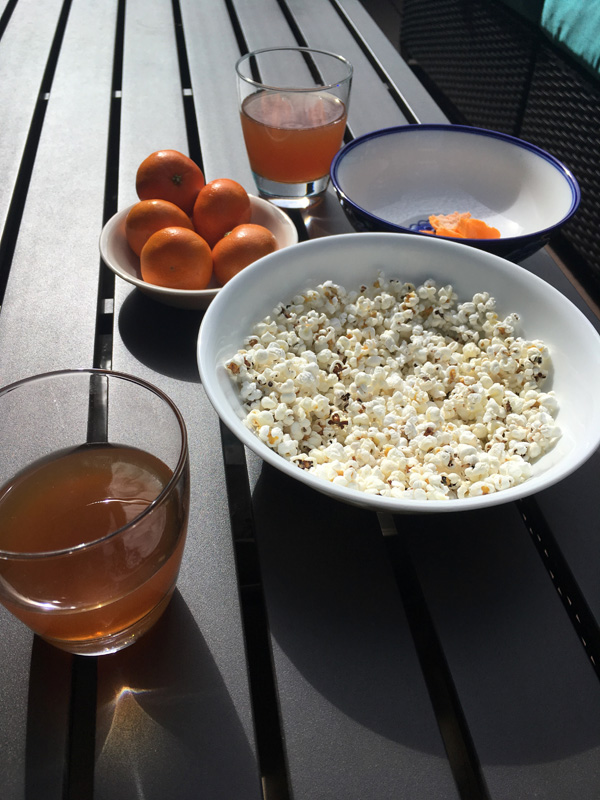Some people think ornamental Indian corn, the kind that shows up in grocery stores around Halloween every year, isn’t edible.
Let’s think about that. The colorful ears of dried corn we hang in our entries to celebrate the fall holidays are the same varieties that were domesticated and grown by American Indians, long before the concept of Halloween decorations and, yes, Thanksgiving, was brought to these shores by European colonizers.
If Indian corn isn’t edible, then the only possible implication is that the American Indians grew it only because they wanted to decorate their lodges and wigwams with it. This doesn’t seem very likely.
When I was a child, occasionally we would run across bundles of “Indian corn” in the supermarket. One year, my parents bought some, and, that being the same year I had my first vegetable garden, I proceeded to plant some of the seeds. As an eight- or nine-year-old, naturally, I had additional questions, and so I asked my father, who knew everything. “Why are these ones so small?” I asked, showing him some of the tiny ears of red strawberry popcorn that was in the bundle. He said, “Oh, that’s probably some kind of popcorn.” This revelation, that the Indians had popcorn — which, up to then, had seemed like a modern invention to me — was so interesting that I carried the memory of this fleeting moment with me for several decades afterward, until one day last year, when I finally had the opportunity to utilize it to full effect.
A friend had invited me to visit the Saturday farmer’s market with her, and afterward, to a glass of wine perhaps, with a light snack of market vegetables at her condo nearby. As our shopping interests at the market tend to diverge, at some point we briefly split up, she to look at ceramics, and me to look for vegetables. It was then I saw something I had not expected: ornamental Indian corn — offered not at a craft stand, but at a vegetable stand, resting proudly in its glory beside more prosaic and practical items such as sweet corn, cucumbers and broccoli.
I immediately forgot about vegetables and focused on the corn which, of course, would probably offer nothing of an immediately edible nature to our anticipated get-together at the condo. As a person who is somewhat introverted by default, I needed at least a semblance of a practical reason to approach the vendor and purchase it. I could use them as seed stock, I told myself, and grow my own for fun, as I had in the past. This was enough. But then, as if I needed more encouragement, what did I see — sitting besides the flashy, rainbow-colored ears of ordinary Indian corn — but several tiny ears of what could only be popcorn! I asked the teenager behind the stand what kind it was. He had no idea, and almost seemed surprised that I was interested in buying any. There were only a few ears of either type on the stand, and not much room for there to have been more — it almost seemed as if someone at the farm had brought some along for kicks, just to see if they would sell. They did.
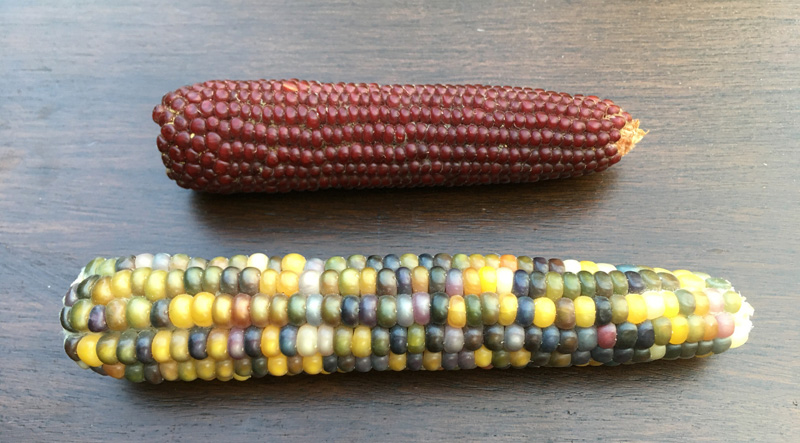
The corn I purchased included several ears of what is probably Glass Gem, pictured at the bottom of the image above. This is not a popcorn, but an Indian flint corn that was further bred in modern times by heirloom corn breeder Carl Barnes, who spent years selecting for the brightest kernels and ended up with these beautiful, translucent colors. There were also three or four ears of red and yellow popcorn, which comes in much smaller cobs and has much smaller kernels. An example is the red ear at the top, which I saved for seed.
When we got to the condo, I insisted that the Indian popcorn could be popped, and that we should do it now. She was skeptical, but allowed me to try, while she went to the patio to find spots for her newly purchased plants. She returned to a bowl of steaming hot kernels — small, but extremely tasty. We spent the afternoon snacking on mangoes, tangerines, and popcorn, under a perfect summer sky.
If you are fortunate enough to find Indian popcorn at your local farmer’s market, you should give it a try. Use your fingernail to remove a few rows of kernels, starting from one end. Then take the whole ear and twist it with your hands, rubbing the rest of the kernels off into a bowl. From this point, you can pop it on the stovetop like any other popcorn. Put a couple of teaspoons of oil in a skillet, place it on high heat for about a minute, and then pour in the kernels. Cover, and shake the pan a few times while waiting for the first kernels to pop. After the popping is well underway, reduce the heat to about half, and continue shaking back and forth on the burner until the popping is basically stopped. Pour out immediately into a bowl.
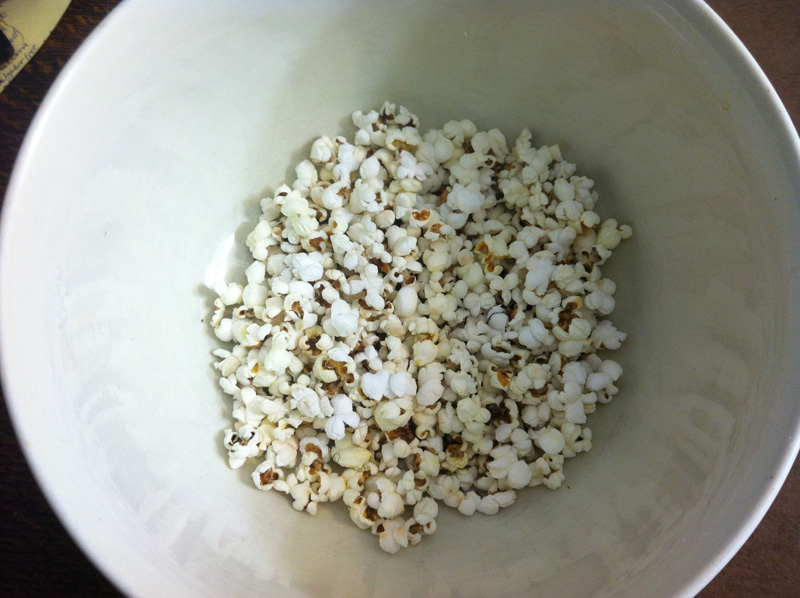
I find that Indian popcorn, when popped this way, needs essentially no seasoning, because its corn flavor is much more intense than modern popcorn. Yes, the kernels are smaller. And it is not as fluffy. But it is delicious.
Several years ago, I planted a variety of open-pollinated heirloom corn in various places around my property. One of the varieties, which I purchased from Sand Hill Preservation Center, was a popcorn type known as “Little Indian Pickling” in their catalog. This was a substitute that was sent in place of another variety that was unavailable that year. After harvesting, I discovered that it is capable of developing a wide variety of colors, ranging from all red to all yellow to all black, and mixtures in between. Unfortunately, corn borers and a persistent squirrel prevented me from harvesting very much.
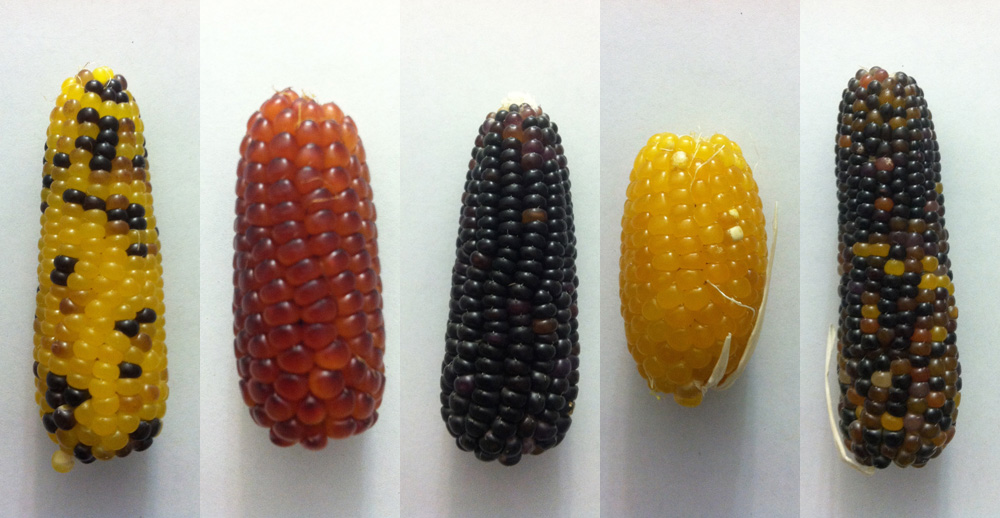
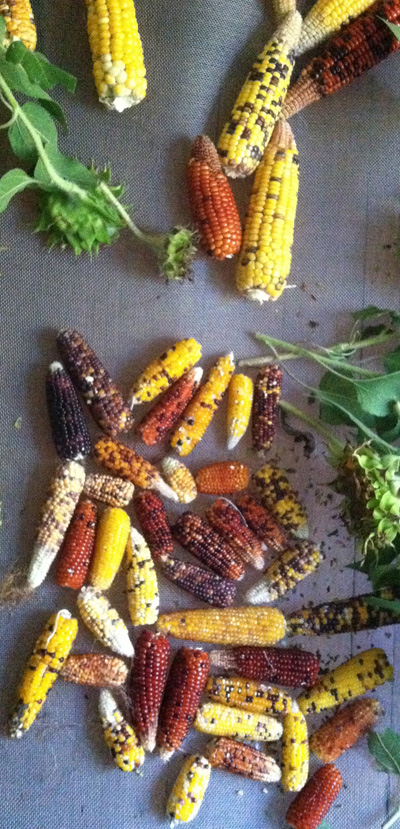
If you try growing some Indian popcorn at home, plan on experiencing a lot of pressure from squirrels and deer, both of which seem instinctively and irresistibly attracted to standing corn stalks, just at the very time in the mid-fall when the ears have fully developed but need to be left on the stalks to dry. I found that it was only by planting a great deal (about ten rows of fifty feet), and picking some a bit earlier than I had planned, was I able to harvest enough to bother drying out and experimenting with.
I placed them on a window screen in a warm upstairs room to dry for several weeks. By sometime over the winter, the kernels had become hard and dry, and they easily separated from the cobs.
Somewhat surprisingly, I found that different colors of corn from this same variety popped sightly differently and had slightly different textures and flavors. Some were better (to my tastes) than others — but all were worth trying, and worth eating. All were good.
Today, there are dozens and dozens of different varieties of native popcorn available at online seed companies — much more than my inner child would have been able to find, whether at the grocery store where his parents shopped, or at the mythical hardware store around the corner, that seemed to have as many types of seeds as my father had facts.
Life is short, and consists mostly of inaction. I encourage you to buck the trend and try as many kinds as you can.
It is enough for me that a brief outing with a treasured, inspiring acquaintance led to the revival and proof of a long forgotten memory, and a bit of knowledge that had traveled with me unfulfilled from my earliest years finally found an outlet in it. Who knew that the sweet memory of that unplanned afternoon, on an urban patio under a spreading cirrus sky, enjoying the fruits of crowded market and wistful memory, would end up comforting us both through a difficult year to come.
